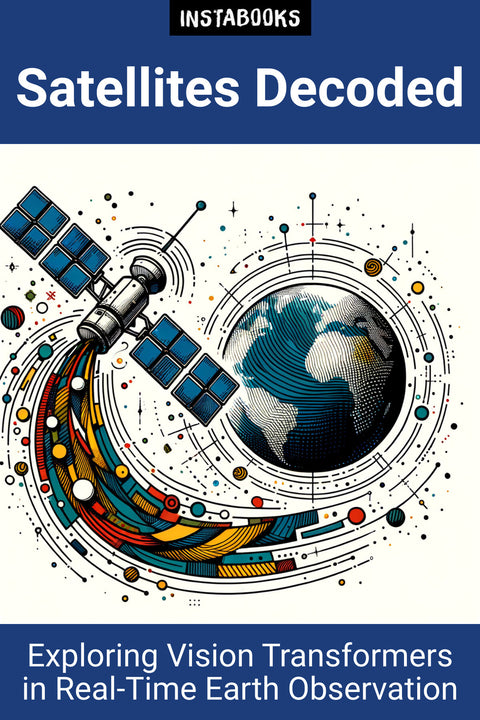
Satellites Decoded
Exploring Vision Transformers in Real-Time Earth Observation
Included:
✓ 200+ Page AI-Generated Book
✓ ePub eBook File — read on Kindle & Apple Books
✓ PDF Print File (Easy Printing)
✓ Word DOCX File (Easy Editing)
✓ Hi-Res Print-Ready Book Cover (No Logo Watermark)
✓ Full Commercial Use Rights — keep 100% of royalties
✓ Publish under your own Author Name
✓ Sell on Amazon KDP, IngramSpark, Lulu, Blurb & Gumroad to millions of readers worldwide
Introduction to Real-Time Satellite Image Classification
In an era where technology meets the dynamics of nature, satellite image classification for Earth Observation is revolutionizing how we monitor and understand our planet. This book delves into the vital role of artificial intelligence, specifically focusing on pre-trained Vision Transformer models, in the realm of on-board satellite image analysis. Whether for monitoring deforestation or assessing natural disaster impacts, the efficiency and accuracy of these models offer unprecedented capabilities in real-time decision-making.
The Shift from CNN to Vision Transformers
Traditionally, convolutional neural networks (CNNs) dominated the scene, but a new era is dawning with Vision Transformers (ViTs). Models such as MobileViTV2 and EfficientViT-M2 now outperform their predecessors by offering enhanced performance under the constraints of satellite technology. Their ability to maintain high accuracy, precision, and recall, even under noisy conditions, is unmatched, making them ideal for the challenging environment of space.
Comparative Analysis: Performance and Robustness
This book presents a comprehensive study comparing numerous ViT variants, including ViT-Base, ViT-Large, and DeiT-Base, each tested under various conditions. We explore these models’ adaptability to different datasets, focusing on their accuracy, inference time, and suitability for on-board processing—a critical aspect for any satellite mission. Moreover, the book addresses the models' effectiveness amid common image corruptions and domain shifts, simulating the conditions encountered in real-world scenarios.
Overcoming Hardware Constraints
A significant challenge in deploying pre-trained ViT models on satellites is their reliance on limited resources. This section discusses innovative strategies like transfer learning, quantization, and fixed-point encoding, ensuring these models operate efficiently on edge devices. By aligning technological advancements with practical applications, we bridge the gap between theoretical capabilities and pragmatic execution in space.
Unlocking Real-Time Potential
The final chapters focus on real-time applications of these innovations, crucial for immediate classification and alert systems. From monitoring floods to detecting wildfires, the capabilities of ViT models transform how satellites execute missions, offering direct implications for fields requiring quick response and minimal terrestrial data transmission.
Conclusion
By integrating thorough research and practical insights, this book serves as an indispensable resource for professionals and enthusiasts alike who aspire to harness the full potential of AI in satellite technology. Whether you're involved in research, development, or application of satellite technologies, discover how these transformative tools pave the way for a future where real-time Earth observation is not just possible but efficient and reliable.
Table of Contents
1. Understanding Earth Observation- The Evolution of Satellite Imaging
- Key Applications in Modern Times
- Technological Advances Shaping EO
2. Artificial Intelligence in Space
- Role of AI in Satellite Technologies
- Challenges and Opportunities
- Future Prospects and Developments
3. Vision Transformers Unveiled
- From CNNs to ViTs
- Pioneering Models and Innovations
- Current Trends and Breakthroughs
4. On-Board Processing Dynamics
- Constraints of Space-Based Hardware
- Optimization Techniques for Efficiency
- Balancing Performance and Resources
5. Comparative Analysis of Models
- Evaluating Performance Metrics
- Real-World Testing Scenarios
- Insights from Recent Studies
6. Achieving Robustness
- Handling Environmental Noise
- Adapting to Image Corruptions
- Ensuring Reliable Data Inference
7. Innovative Deployment Strategies
- Utilizing Transfer Learning
- Implementing Quantization Techniques
- Advancing Fixed-Point Encoding
8. Real-Time Applications
- Monitoring Natural Disasters
- Environmental Change Detection
- Rapid Response Mechanisms
9. Future of On-Board AI
- Enhancing AI Capabilities
- Next-Gen Satellite Missions
- Predicting Technological Evolutions
10. Ethical and Legal Considerations
- Privacy Concerns in EO
- Regulatory Frameworks
- Balancing Technology and Ethics
11. Case Studies in EO
- Lessons from Disaster Response
- Success Stories in Conservation
- Collaborative Global Efforts
12. Conclusion and Roadmap Ahead
- Key Takeaways and Insights
- Strategies for Continued Innovation
- Vision for the Future of EO
Target Audience
This book is intended for researchers, engineers, students, and professionals interested in satellite technology, Earth Observation, and AI applications.
Key Takeaways
- In-depth understanding of Vision Transformers in satellite image classification.
- Challenges and strategies for on-board AI deployment under hardware constraints.
- Comprehensive comparison of various ViT models for real-time applications.
- Techniques to enhance the robustness and efficiency of AI models in space.
- Real-world applications and case studies demonstrating AI in Earth Observation.
